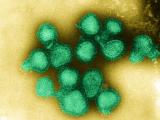Oct 18, 2010 (CIDRAP News) – Flu is circulating at low levels in the United States, with the 2009 H1N1 virus appearing sporadically along with H3N2 and influenza B strains, the US Centers for Disease Control and Prevention (CDC) said in its first official surveillance report of the new season.
Flu activity is sporadic in 19 states, the District of Columbia, Guam, and Puerto Rico, with 31 states reporting no flu activity, the CDC said in its report for the week ending Oct 9. The number of outpatient visits for flu is below the national baseline, and flu- and pneumonia-related deaths are below the epidemic threshold. No pediatric deaths were reported.
In its review of ILINet state flu activity data, which allows the CDC to compare outpatient visits for flulike illnesses in each state with averages for spring and fall periods with little or no flu activity, activity was at minimal levels in 48 states and New York City. There weren’t enough data to gauge activity levels in the District of Columbia, Kentucky, and Maryland.
The CDC also included links to other surveillance sources in its weekly update. The Distribute Project, a syndromic surveillance collaboration between the CDC and the International Society for Disease Surveillance, suggested that emergency department visits for flulike illnesses were up in the region that includes Colorado, Montana, the Dakotas, Utah, and Wyoming, according to an update today. Meanwhile, Google Flu Trends, in an update yesterday, suggested that flu activity across the nation is low, with levels normally seen this time of year. Google Flu Trends measures flu-related Web searches.
About 3% of respiratory specimens tested were positive for influenza, the CDC said. Among the influenza A samples, about 13% were the 2009 H1N1 virus, 16% were H3N2, and 71% weren't subtyped. Influenza B accounted for about 33% of the positive samples.
Most of the viruses were closely related to components included in this season's Northern Hemisphere flu vaccine. About three quarters of the influenza B viruses that were subtyped belonged to the Victoria lineage, which is included in the vaccine.
In other flu-related developments, Minnesota health officials today warned that a greater proportion of H3N2 viruses circulating in the nation this year could make for a difficult flu season for the elderly. The Minnesota Department of Health (MDH) said a woman in her 80s from the southeastern part of the states died last week from H3N2 infection complications and that earlier this month a woman in her 80s from the Twin Cities area also died after an H3N2 flu infection. Both women were residents of long-term care facilities, the MDH said in a press release.
Dr Ruth Lynfield, Minnesota's state epidemiologist, said in the press release, "In years when there has been primarily H3 influenza A circulating, we've seen higher rates of serious illness, particularly in the elderly."
Lynfield urged people who live with or care for the elderly, especially healthcare workers, to receive the seasonal flu vaccine.
Over the past few months US and global health officials have been tracking a rising percentage of flu infections caused by the H3N2 virus. CDC officials have said they expect to see more of the virus in the United States this season, which they say could portend a more difficult season and is another reason for the public to get vaccinated.
The CDC said in an Oct 14 vaccine supply update that 129 million flu vaccine doses have already been distributed. Vaccine companies expect to make about 160 to 165 million vaccine doses for the US market this season, a record number. This is the first year of the federal government's universal flu vaccination recommendation; all people age 6 months and older are urged to receive the vaccine.
See also:
Oct 15 CDC flu surveillance report
Oct 18 Minnesota Department of Health press release
Oct 14 CDC flu vaccine update



















